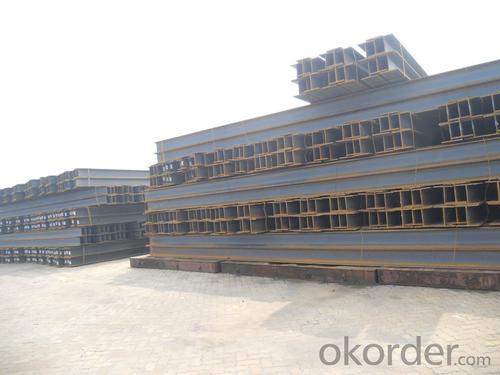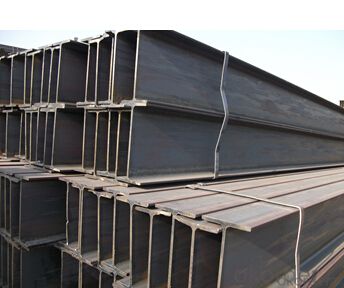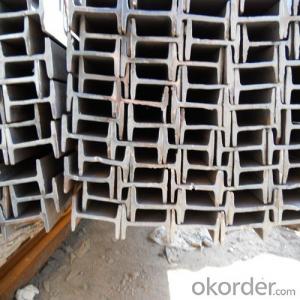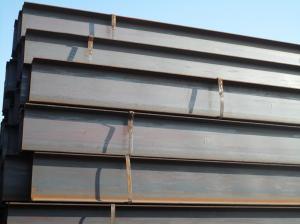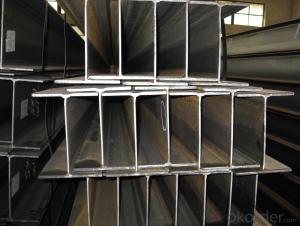JIS 3192 Hot Rolled Steel H-beam
- Loading Port:
- China Main Port
- Payment Terms:
- TT or LC
- Min Order Qty:
- -
- Supply Capability:
- -
OKorder Service Pledge
OKorder Financial Service
You Might Also Like
Product Description:
OKorder is offering JIS 3192 Hot Rolled Steel H-beam at great prices with worldwide shipping. Our supplier is a world-class manufacturer of steel, with our products utilized the world over. OKorder annually supplies products to European, North American and Asian markets. We provide quotations within 24 hours of receiving an inquiry and guarantee competitive prices.
Product Applications:
JIS 3192 Hot Rolled Steel H-beam are ideal for structural applications and are widely used in the construction of buildings and bridges, and the manufacturing, petrochemical, and transportation industries.
Product Advantages:
OKorder's JIS 3192 Hot Rolled Steel H-beam are durable, strong, and resist corrosion.
Main Product Features:
· Premium quality
· Prompt delivery & seaworthy packing (30 days after receiving deposit)
· Corrosion resistance
· Can be recycled and reused
· Mill test certification
· Professional Service
· Competitive pricing
Secifications of JIS 3192 Hot Rolled Steel H-beam
1. Standard: JIS 3192
2. Grade: SS400 or Equivalent
3. Length: 10m, 12m as following table
4. Invoicing on theoretical weight or actual weight as customer request
5.Payment: TT or L/C
6. Sizes:
H x B (mm) | T1 | T2 | JIS Weight (kg/m) | GB Weight (kg/m) |
100*100 | 6 | 8 | 16.9 | 17.2 |
125*125 | 6.5 | 9 | 23.6 | 23.8 |
150*75 | 5 | 7 | 14 | 14.3 |
148*100 | 6 | 9 | 20.7 | 21.4 |
150*150 | 7 | 10 | 31.1 | 31.9 |
175*90 | 5 | 8 | 18 | 18.2 |
175*175 | 7.5 | 11 | 40.4 | 40.4 |
198*99 | 4.5 | 7 | 17.8 | 18.5 |
200*100 | 5.5 | 8 | 20.9 | 21.7 |
194*150 | 6 | 9 | 29.9 | 31.2 |
200*200 | 8 | 12 | 49.9 | 50.5 |
248*124 | 5 | 8 | 25.1 | 25.8 |
250*125 | 6 | 9 | 29 | 29.7 |
244*175 | 7 | 11 | 43.6 | 44.1 |
250*250 | 9 | 14 | 71.8 | 72.4 |
298*149 | 5.5 | 8 | 32 | 32.6 |
298*201 | 9 | 14 | 65.4 |
|
300*150 | 6.5 | 9 | 36.7 | 37.3 |
294*200 | 8 | 12 | 55.8 | 57.3 |
300*300 | 10 | 15 | 93 | 94.5 |
346*174 | 6 | 9 | 41.2 | 41.8 |
350*175 | 7 | 11 | 49.4 | 50 |
340*250 | 9 | 14 | 78.1 | 79.7 |
350*350 | 12 | 19 | 135 | 137 |
400*200 | 8 | 13 | 65.4 | 66 |
390*300 | 10 | 16 | 105 | 107 |
400*400 | 13 | 21 | 172 | 172 |
446*199 | 8 | 12 | 65.1 | 66.7 |
450*200 | 9 | 14 | 77.9 | 79.5 |
440*300 | 11 | 18 | 121 | 124 |
496*199 | 9 | 14 | 77.9 | 79.5 |
500*200 | 10 | 16 | 88.2 | 89.6 |
488*300 | 11 | 18 | 125 | 129 |
596*199 | 10 | 15 | 92.5 | 95.1 |
600*200 | 11 | 17 | 103.4 | 106 |
588*300 | 12 | 20 | 147 | 151 |
700*300 | 13 | 24 | 182 | 185 |
800*300 | 14 | 26 | 207 | 210 |
900*300 | 16 | 28 | 240.1 | 243 |
Usage & Applications of Hot Rolled Steel H-beam
Commercial building structure ;Pre-engineered buildings; Machinery support structure; Prefabricated structure; Medium scale bridges; Ship-building structure.etc.
Packaging & Delivery of Hot Rolled Steel H-beam
1. Packing: it is nude packed in bundles by steel wire rod
2. Bundle weight: not more than 3.5MT for bulk vessel; less than 3 MT for container load
3. Marks:
Color marking: There will be color marking on both end of the bundle for the cargo delivered by bulk vessel. That makes it easily to distinguish at the destination port.
Tag mark: there will be tag mark tied up on the bundles. The information usually including supplier logo and name, product name, made in China, shipping marks and other information request by the customer.
If loading by container the marking is not needed, but we will prepare it as customer request.
4. Transportation: the goods are delivered by truck from mill to loading port, the maximum quantity can be loaded is around 40MTs by each truck. If the order quantity cannot reach the full truck loaded, the transportation cost per ton will be little higher than full load.
5. Delivered by container or bulk vessel
Production flow of Hot Rolled Steel H-beam
Material prepare (billet) —heat up—rough rolling—precision rolling—cooling—packing—storage and transportation
FAQ:
Q1: Why buy Materials & Equipment from OKorder.com?
A1: All products offered byOKorder.com are carefully selected from China's most reliable manufacturing enterprises. Through its ISO certifications, OKorder.com adheres to the highest standards and a commitment to supply chain safety and customer satisfaction.
Q2: How do we guarantee the quality of our products?
A2: We have established an advanced quality management system which conducts strict quality tests at every step, from raw materials to the final product. At the same time, we provide extensive follow-up service assurances as required.
Q3: How soon can we receive the product after purchase?
A3: Within three days of placing an order, we will begin production. The specific shipping date is dependent upon international and government factors, but is typically 7 to 10 workdays.

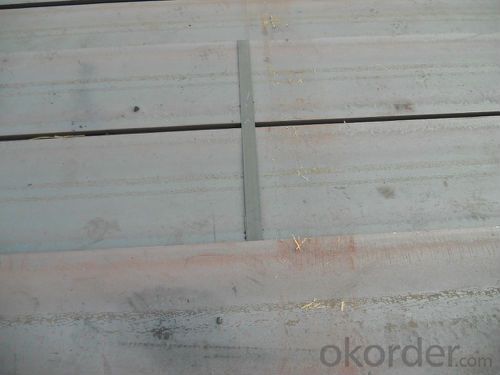
- Q: What are the common inspection methods for steel H-beams?
- The common inspection methods for steel H-beams include visual inspection, dimensional checks, and non-destructive testing techniques such as ultrasonic testing and magnetic particle inspection. These methods are used to ensure the quality, accuracy, and structural integrity of the H-beams.
- Q: Can steel H-beams be used in the construction of shopping malls?
- Yes, steel H-beams can be used in the construction of shopping malls. Steel H-beams are widely used in commercial and industrial construction projects due to their strength, durability, and versatility. They provide structural support and stability, making them suitable for large-scale projects like shopping malls. The use of steel H-beams ensures the integrity of the building's framework, allowing for wide-open spaces and flexibility in design.
- Q: Can steel H-beams be used for theaters or auditoriums?
- Certainly! The utilization of steel H-beams in theaters or auditoriums is possible. Due to their robustness and ability to bear heavy loads, steel H-beams are frequently employed in construction. They offer structural reinforcement, making them well-suited for expansive areas such as theaters or auditoriums. Moreover, steel H-beams provide versatility in design, enabling the creation of airy and open layouts that are often sought after in these particular venues.
- Q: Are Steel H-Beams resistant to termite or insect damage?
- Yes, steel H-beams are resistant to termite or insect damage. Unlike wooden beams, steel beams do not provide a food source for termites or other insects, making them highly resistant to infestation. Steel beams are made from a combination of iron and carbon, which do not attract or support termite colonies. This resistance to termite or insect damage is one of the many advantages of using steel H-beams in construction projects, as it ensures the structural integrity and longevity of the beams.
- Q: How do steel H-beams contribute to the overall sound insulation of a building?
- Steel H-beams do not directly contribute to the overall sound insulation of a building. Sound insulation primarily depends on the materials used for walls, floors, and ceilings, as well as the construction techniques employed. However, steel H-beams can indirectly affect sound insulation in a building in a few ways. Firstly, they provide structural support to the building, ensuring stability and preventing vibrations. This can help minimize the transmission of sound caused by vibrations from external sources, such as traffic or machinery, into the building. Additionally, steel H-beams can be used in the construction of suspended ceilings or raised floors, which are often designed to enhance sound insulation. These components can incorporate insulation materials, such as mineral wool or acoustic mats, that help to absorb sound and reduce its transmission between different areas of the building. Furthermore, steel H-beams can be utilized in the construction of partition walls, which can play a role in sound insulation between different rooms or units within a building. By providing a sturdy framework, H-beams can support soundproofing materials, such as dense gypsum boards or acoustic panels, which effectively reduce sound transmission. While steel H-beams themselves do not directly contribute to sound insulation, their use in building construction can support the implementation of soundproofing measures and enhance the overall acoustic performance of a building.
- Q: Can steel H-beams be used for supporting elevated walkways or platforms?
- Indeed, elevated walkways or platforms can be supported by steel H-beams. In construction, steel H-beams are frequently employed due to their robustness and endurance. Their exceptional load-bearing capacities make them well-suited for sustaining structures like walkways and platforms. The H-shaped configuration of these beams enables superior weight distribution and resistance against bending or twisting forces, guaranteeing stability and safety for elevated constructions. Moreover, steel H-beams can be conveniently fabricated and installed, rendering them a pragmatic selection for such purposes.
- Q: What are the structural integrity considerations for steel H-beams?
- Structural integrity considerations for steel H-beams involve factors such as load capacity, deflection, bending, and stability. These beams need to be designed and manufactured to withstand the expected loads and forces they will be subjected to in a particular application. The dimensions and material properties of the beam, as well as the connection details, must be carefully analyzed to ensure they meet the required safety standards and provide sufficient strength and stability for the intended use. Additionally, considerations for factors like corrosion resistance, fire resistance, and environmental conditions may also play a role in ensuring the long-term structural integrity of steel H-beams.
- Q: Can steel H-beams be used in the construction of parking structures or garages?
- Steel H-beams are indeed suitable for the construction of parking structures or garages. Widely utilized in the construction industry, H-beams are valued for their strength, durability, and ability to bear heavy loads. With their capacity to withstand substantial weight, they are well-suited for the creation of multi-story parking structures or garages. Additionally, steel H-beams possess a number of advantages. They are lightweight, simplifying the construction process and reducing expenses. Moreover, they offer flexibility in design, allowing for greater freedom in architectural layouts. In conclusion, steel H-beams are a favored option for the construction of parking structures or garages due to their structural integrity and versatility.
- Q: What are the disadvantages of using steel H-beams?
- There exist multiple drawbacks associated with the utilization of steel H-beams in construction endeavors. To begin with, steel H-beams possess a relatively heavy weight in comparison to other construction materials. This characteristic can present challenges during transportation and installation, particularly in projects that necessitate large quantities of beams. Furthermore, the weight of steel H-beams contributes to the overall load-bearing capacity of the structure, potentially requiring additional reinforcement or support. In addition, if not adequately protected, steel H-beams are susceptible to corrosion. Exposure to moisture and harsh weather conditions can lead to rust and structural deterioration over time. To prevent corrosion, extra measures such as galvanization or regular maintenance become necessary, which increase the overall cost and effort involved. Furthermore, when juxtaposed with certain alternative materials, steel H-beams do not possess the same level of environmental friendliness. The production of steel demands significant energy consumption and results in substantial carbon dioxide emissions, thereby contributing to climate change. Moreover, steel is not a renewable resource and necessitates mining and extraction, processes that can have detrimental effects on the environment. Lastly, steel H-beams offer limited design flexibility when compared to alternative materials. The standard shape and size of H-beams may not always align with specific architectural or structural designs. This limitation can curtail the creativity and customization options available to architects and engineers, potentially compromising the overall aesthetics or functionality of the project. In summary, while steel H-beams boast numerous advantages such as high strength and durability, it is essential to consider these disadvantages, including weight, corrosion, environmental impact, and design limitations, when making a decision regarding their usage in a construction project.
- Q: Can steel H-beams be used for supporting shipyard structures?
- Indeed, shipyard structures can indeed be supported by steel H-beams. Due to their remarkable strength and capacity for bearing heavy loads, steel H-beams are widely employed in construction. They are especially well-suited for the support of weighty structures typically found in shipyards. The H-shaped design of these beams ensures superb structural stability and enables the efficient dispersal of the load. Furthermore, steel possesses exceptional durability, enabling it to withstand the harsh marine environments commonly encountered in shipyard settings. Consequently, steel proves to be an optimal material choice for shipyard structures.
Send your message to us
JIS 3192 Hot Rolled Steel H-beam
- Loading Port:
- China Main Port
- Payment Terms:
- TT or LC
- Min Order Qty:
- -
- Supply Capability:
- -
OKorder Service Pledge
OKorder Financial Service
Similar products
Hot products
Hot Searches
Related keywords






